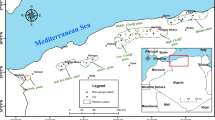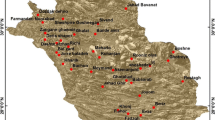Abstract
Drought over a period threatens the water resources, agriculture, and socioeconomic activities. Therefore, it is crucial for decision makers to have a realistic anticipation of drought events to mitigate its impacts. Hence, this research aims at using the standardized precipitation index (SPI) to predict drought through time series analysis techniques. These adopted techniques are autoregressive integrating moving average (ARIMA) and feed-forward backpropagation neural network (FBNN) with different activation functions (sigmoid, bipolar sigmoid, and hyperbolic tangent). After that, the adequacy of these two techniques in predicting the drought conditions has been examined under arid ecosystems. The monthly precipitation data used in calculating the SPI time series (SPI 3, 6, 12, and 24 timescales) have been obtained from the tropical rainfall measuring mission (TRMM). The prediction of SPI was carried out and compared over six lead times from 1 to 6 using the model performance statistics (coefficient of correlation (R), mean absolute error (MAE), and root mean square error (RMSE)). The overall results prove an excellent performance of both predicting models for anticipating the drought conditions concerning model accuracy measures. Despite this, the FBNN models remain somewhat better than ARIMA models with R ≥ 0.7865, MAE ≤ 1.0637, and RMSE ≤ 1.2466. Additionally, the FBNN based on hyperbolic tangent activation function demonstrated the best similarity between actual and predicted for SPI 24 by 98.44%. Eventually, all the activation function of FBNN models has good results respecting the SPI prediction with a small degree of variation among timescales. Therefore, any of these activation functions can be used equally even if the sigmoid and bipolar sigmoid functions are manifesting less adjusted R2 and higher errors (MAE and RMSE). In conclusion, the FBNN can be considered a promising technique for predicting the SPI as a drought monitoring index under arid ecosystems.










Similar content being viewed by others
References
Adeyewa ZD, Nakamura K (2003) Validation of TRMM radar rainfall data over major climatic regions in Africa. J Appl Meteorol 42:331–347
Asadi Zarch MA, Sivakumar B, Sharma A (2015) Droughts in a warming climate: a global assessment of standardized precipitation index (SPI) and reconnaissance drought index (RDI). J Hydrol 526:183–195
Ayuso LJ, Ayuso-Ruiz P, García-Marín PA, Estévez J, Taguas VE (2015) Local analysis of the characteristics and frequency of extreme droughts in Málaga using the SPI (standardized precipitation index). In: Ayuso Muñoz LJ, Yagüe Blanco LJ, Capuz-Rizo FS (eds) Project management and engineering: selected papers from the 17th international AEIPRO Congress held in Logroño, Spain, in 2013. Springer International Publishing, Cham, pp 167–179
Belayneh A, Adamowski J, Khalil B, Ozga-Zielinski B (2014) Long-term SPI drought forecasting in the Awash River Basin in Ethiopia using wavelet neural network and wavelet support vector regression models. J Hydrol 508:418–429
Bowden JH, Talgo KD, Spero TL, Nolte CG (2016) Assessing the added value of dynamical downscaling using the standardized precipitation index. Adv Meteorol 2016:14
Box GEP, Jenkins GM (1976) Time series analysis. Forecasting and control. Revised ed. Holden-Day, San Francisco, p 575
Brockwell PJ, Davis RA (2002) Introduction to time series and forecasting, 2nd edn. Springer, New York, p 437
Brown ME (2008) Famine early warning systems and remote sensing data. Springer, Berlin, p 78
Collischonn B, Collischonn W, Tucci CEM (2008) Daily hydrological modeling in the Amazon basin using TRMM rainfall estimates. J Hydrol 360:207–216
Dinku T, Ceccato P, Grover-Kopec E, Lemma M, Connor SJ, Ropelewski CF (2007) Validation of satellite rainfall products over East Africa's complex topography. Int J Remote Sens 28:1503–1526
Estrela T, Vargas E (2012) Drought management plans in the European Union. The case of Spain. Water Resour Manag 26:1537–1553
Farokhnia A, Morid S, Byun H-R (2011) Application of global SST and SLP data for drought forecasting on Tehran plain using data mining and ANFIS techniques. Theor Appl Climatol 104:71–81
Heim RR (2002) A review of twentieth-century drought indices used in the United States. Bull Am Meteorol Soc 83:1149–1165
Hosseini-Moghari SM, Araghinejad S (2015) Monthly and seasonal drought forecasting using statistical neural networks. Environ Earth Sci 74:397–412
Huang S, Huang Q, Chang J, Leng G, Xing L (2015) The response of agricultural drought to meteorological drought and the influencing factors: a case study in the Wei River Basin, China. Agric Water Manag 159:45–54
Huang YF, Ang JT, Tiong YJ, Mirzaei M, Amin MZM (2016) Drought forecasting using SPI and EDI under RCP-8.5 climate change scenarios for Langat River Basin, Malaysia. Procedia Eng 154:710–717
Ionita M, Scholz P, Chelcea S (2016) Assessment of droughts in Romania using the standardized precipitation index. Nat Hazards 81:1483–1498
Karakoc U, Patil S (2016) Comparison of TRMM satellite and ground-based precipitation data for predicting streamflow in Kucuk Menderes River Basin, Turkey. In: EGU General Assembly Conference Abstracts, p 1467
Khashei M, Bijari M (2011) A novel hybridization of artificial neural networks and ARIMA models for time series forecasting. Appl Soft Comput 11:2664–2675
Le MH, Perez GC, Solomatine D, Nguyen LB (2016) Meteorological drought forecasting based on climate signals using artificial neural network—a case study in Khanhhoa Province Vietnam. Procedia Eng 154:1169–1175
Li X-H, Zhang Q, Xu C-Y (2012) Suitability of the TRMM satellite rainfalls in driving a distributed hydrological model for water balance computations in Xinjiang catchment, Poyang Lake Basin. J Hydrol 426–427:28–38
Li X, Zhang Q, Ye X (2013) Dry/wet conditions monitoring based on TRMM rainfall data and its reliability validation over Poyang Lake Basin, China. Water 5:1848–1864
Lohani VK, Loganathan GV, Mostaghimi S (1998) Long-term analysis and short-term forecasting of dry spells by palmer drought severity index. Hydrol Res 29:21–40
Maca P, Pech P (2016) Forecasting SPEI and SPI drought indices using the integrated artificial neural networks. Intell Neuroscience 2016:14–14
Mahfouz P, Mitri G, Jazi M, Karam F (2016) Investigating the temporal variability of the standardized precipitation index in Lebanon. Climate 4:27
McKee T, Doesken N, Kleist J (1993) The relation of drought frequency and duration to time scales. In: Proceedings of the 8th Conference on Applied Climatology, Anaheim, CA. American Meteorological Society, Boston, MA, pp 179–184
Meng J, Li L, Hao Z, Wang J, Shao Q (2014) Suitability of TRMM satellite rainfall in driving a distributed hydrological model in the source region of Yellow River. J Hydrol 509:320–332
Mishra AK, Desai VR (2005) Drought forecasting using stochastic models. Stoch Environ Res Ris Assess 19:326–339
Mishra AK, Desai VR (2006) Drought forecasting using feed-forward recursive neural network. Ecol Model 198:127–138
Mishra A, Desai V, Singh V (2007) Drought forecasting using a hybrid stochastic and neural network model. J Hydrol Eng 12:626–638
Morid S, Smakhtin V, Bagherzadeh K (2007) Drought forecasting using artificial neural networks and time series of drought indices. Int J Climatol 27:2103–2111
Musuuza JL, Van Loon AF, Teuling AJ (2016) Multiscale evaluation of the standardized precipitation index as a groundwater drought indicator. Hydrol Earth Syst Sci 20:1117
Nam W-H, Hayes MJ, Svoboda MD, Tadesse T, Wilhite DA (2015) Drought hazard assessment in the context of climate change for South Korea. Agric Water Manag 160:106–117
Naumann G, Barbosa P, Carrao H, Singleton A, Vogt J (2012) Monitoring drought conditions and their uncertainties in Africa using TRMM data. J Appl Meteorol Climatol 51:1867–1874
Nicholson SE et al (2003) Validation of TRMM and other rainfall estimates with a high-density gauge dataset for West Africa. Part II: validation of TRMM rainfall products. J Appl Meteorol 42:1355–1368
Oh K, Yu I, Kim H, Kim S, Kim L-h, Jeong S (2015) Drought assessment based on real-time drought index. Desalin Water Treat 53:3111–3117
Olivares BO, Cortez A, Lobo D, Parra RM, Rey BJC, Rodríguez MF (2016) Study of meteorological drought in the venezuelan plains using the standardized precipitation index. Acta Nova 7:266
Qureshi AS, Akhtar M (2004) Analysis of drought-coping strategies in Baluchistan and Sindh provinces of Pakistan. Sri Lanka, International Water Management Institute, Working paper 86
Raudkivi AJ (2013) Hydrology: an advanced introduction to hydrological processes and modelling. Elsevier Science, p 272
Ren W, Wang Y, Li J, Feng P, Smith RJ (2016) Drought forecasting in Luanhe River basin involving climatic indices. Theor Appl Climatol 130:1133–1148
Rezaeianzadeh M, Stein A, Cox JP (2017) Drought forecasting using Markov chain model and artificial neural networks. Water Resour Manag 30:2245–2259
Rhee J, Carbone GJ (2011) Estimating drought conditions for regions with limited precipitation data. J Appl Meteorol Climatol 50:548–559
Sassa K, Canuti P, Yin Y (2014) Landslide science for a safer geoenvironment. Volume 2: methods of landslide studies. Springer International Publishing, p 302
Shafaei M, Kisi O (2016) Predicting river daily flow using wavelet-artificial neural networks based on regression analyses in comparison with artificial neural networks and support vector machine models. Neural Comput Appl 28:15–28
Simons G, Bastiaanssen W, Ngô LA, Hain CR, Anderson M, Senay G (2016) Integrating global satellite-derived data products as a pre-analysis for hydrological modelling studies: a case study for the Red River Basin. Remote Sens 8:279
Smakhtin VU, Hughes DA (2004) Review, automated estimation and analyses of drought indices in South Asia. International Water Management Institute, p 24
Soh YW, Koo CH, Huang YF, Fung KF (2018) Application of artificial intelligence models for the prediction of standardized precipitation evapotranspiration index (SPEI) at Langat River Basin, Malaysia. Comput Electron Agric 144:164–173
Strelcová K et al (2008) Bioclimatology and natural hazards. Springer, Netherlands, p 87
Su F, Hong Y, Lettenmaier DP (2008) Evaluation of TRMM Multisatellite precipitation analysis (TMPA) and its utility in hydrologic prediction in the La Plata Basin. J Hydrometeorol 9:622–640
Tang G, Zeng Z, Long D, Guo X, Yong B, Zhang W, Hong Y (2016) Statistical and hydrological comparisons between TRMM and GPM Level-3 products over a Midlatitude Basin: is day-1 IMERG a good successor for TMPA 3B42V7? J Hydrometeorol 17:121–137
Tao H, Fischer T, Zeng Y, Fraedrich K (2016) Evaluation of TRMM 3B43 precipitation data for drought monitoring in Jiangsu Province, China. Water 8:221
Thom HCS (1958) A note on the gamma distribution. Mon Weather Rev 86:117–122
Tian M, Wang P, Khan J (2016) Drought forecasting with vegetation temperature condition index using ARIMA models in the Guanzhong Plain. Remote Sens 8:690
Traore S, Luo Y, Fipps G (2016) Deployment of artificial neural network for short-term forecasting of evapotranspiration using public weather forecast restricted messages. Agric Water Manag 163:363–379
Valipour M (2016) Optimization of neural networks for precipitation analysis in a humid region to detect drought and wet year alarms. Meteorol Appl 23:91–100
Zakhrouf M, Bouchelkia H, Stamboul M (2016) Neuro-Wavelet (WNN) and Neuro-Fuzzy (ANFIS) systems for modeling hydrological time series in arid areas. A case study: the catchment of Aïn Hadjadj (Algeria). Desalin Water Treat 57:17182–17194
Zhang GP (2003) Time series forecasting using a hybrid ARIMA and neural network model. Neurocomputing 50:159–175
Acknowledgements
Analyses and visualizations used in this paper were produced with the Giovanni online data system, developed and maintained by the NASA GES DISC.
Funding
The Project was Financially Supported by King Saud University, Vice Deanship of Research Chairs.
Author information
Authors and Affiliations
Corresponding author
Rights and permissions
About this article
Cite this article
Mossad, A., Alazba, A.A. Determination and prediction of standardized precipitation index (SPI) using TRMM data in arid ecosystems. Arab J Geosci 11, 132 (2018). https://doi.org/10.1007/s12517-018-3487-5
Received:
Accepted:
Published:
DOI: https://doi.org/10.1007/s12517-018-3487-5




